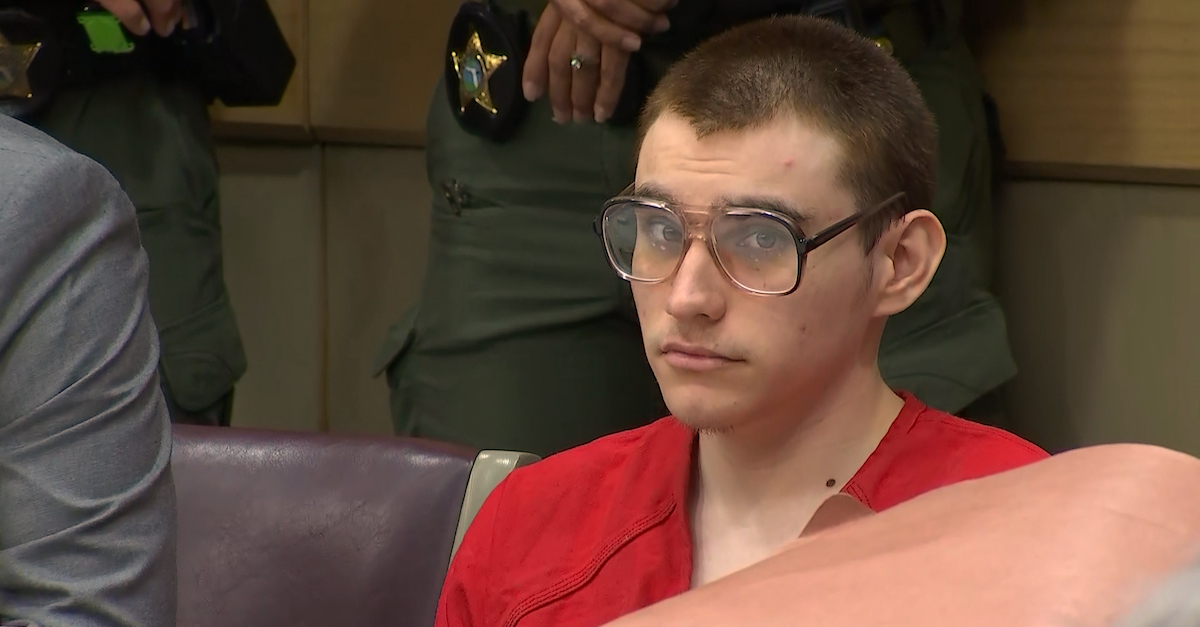
Florida prosecutors are asking a judge to allow them to present evidence to a jury that Nikolas Cruz drew swastikas on both sides of an AR-15 gun magazine and on boots used during the Parkland school shooting. That’s according to documents and photos filed recently in Florida’s Seventeenth Judicial Circuit in Broward County, where Cruz is being tried.
The presence of the swastikas has long been reported through unnamed sources but appears not to have been acknowledged by the government in court records until this month. Images submitted by prosecutors show the swastikas.

The evidence is described more specifically as “a firearm magazine etched with swastikas on each side of the magazine located in the AR-15 firearm used in the shooting and left at the scene,” and as “the boots worn by the Defendant when he was arrested approximately an hour and twenty minutes after the shooting began.” The defendant’s footwear bore “a hand-etched swastika on the right boot.”

Cruz faces 17 counts of murder in the first degree and 17 counts of attempted murder in the Valentine’s Day 2018 massacre. Five of the 17 victims who died were members of the Jewish faith.
The shootings took but six minutes, prosecutors say. The shooter abandoned his gun in a stair well. Video from the school shows that the shooter wore clothing associated with the school’s Junior Reserve Officer Training Corps, or JROTC. Cruz was later arrested wearing the same clothing, but the clothing was standard to JROTC students at Parkland about that time.
Jameson Todd “JT” Snead, the biological son of James and Kimberly Snead, said the gun with the swastikas belonged to Cruz. Cruz lived with the Sneads at the time of the shooting.

That identification is the critical link prosecutors are attempting to use the evidence to prove.
“[D]istinguishing the defendant from other students in attendance on February 14, 2018, is crucial to establishing the Defendant’s identity as the shooter,” prosecutors wrote. “The hand-etched swastika on [Cruz’s] boot is therefore relevant to prove he was the shooter that left the firearm magazine hand-etched with swastikas at the scene of the murders. JT Snead’s identification of the firearm magazine with the hand-etched swastikas as belonging to the Defendant serves to prove the Defendant’s identity as the shooter,” they later said.
The swastikas on the magazine, the boot, and JT Snead’s identification “shows a clear nexus and corroboration as to the identity of the shooter” being Nikolas Cruz, they elsewhere said. “Identity is a critical element of the crimes charged in the indictment, the proof of which the State must establish.”
In other words, it was Cruz, per the state’s argument, and not someone else, who pulled the trigger and killed 17 people.
Interestingly, though, Cruz has already admitted to the shooting. His attorneys were poised to plead guilty in an attempt to avoid the death penalty, but prosecutors refused to allow such a move.
In its motion, the state notes a fundamental hurdle of evidence law that it must clear in order to submit the evidence of the swastikas to a jury: even “[r]elevant evidence is inadmissible if its probative value is substantially outweighed by the danger of unfair prejudice, confusion of issues, misleading the jury, or needless presentation of cumulative evidence.”
In other words, the evidence can’t simply make the jury hate the defendant or prove he’s a loathsome person; it must prove he committed a crime. Or, as the state puts it (citations omitted):
Evidence is relevant to prove identity. Identity is an element that must be proven by the State. The simple fact that evidence may be prejudicial does not make it inadmissible, nor violate due process.
The Supreme Court of Florida has approved the admission of a “swastika” and other hate symbols under circumstances that were considerably more prejudicial than presented here.
The state argues that “[t]he hand-etched swastikas in this case are relevant to establish the identity of the Defendant and connect him to the weapon found at the scene of the crime” but admits that the evidence may be otherwise inadmissible. “The state has no intention of arguing the racist nature of the symbol or that the Defendant is a racist. The admission of the hand-etched swastikas is for identification purposes, not to establish the Defendant’s character or tendencies.”
Character evidence is as a general matter inadmissible under most Rules of Evidence, including Florida’s Rule 90.404.
Read the full filing below:
Nikolas Cruz – Admissibility of Relevant Evidence Hand-Etched Swastikas by Law&Crime on Scribd
Law&Crime Daily Executive Producer Jennifer Tintner contributed to this report.
[Image of Cruz via screen capture from the Law&Crime Network. Images of gun and boot via Broward County, Fla. Court Records.]